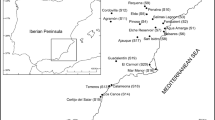Abstract
The relationship of environmental and soil-nutrient variables with the floristic composition of Empetrum rubrum heathlands and related communities from northern Tierra del Fuego were studied by means of ordination techniques. A floristic gradient was found which had its axis of major variation closely related to a gradient in soil trophic status. Increases in the densities of Empetrum and other cushion plants (Bolax gummifera, Azorella lycopodioides, Pernettya pumila) along the floristic gradient were: (a) associated with a lower number of species and total cover, and greater soil erosion; (b) positively correlated with the C/N ratio and aluminium content in the soil; and (c) negatively correlated with pH, calcium content and base saturation.
Climate, lithology, habitat exposure, and the history of human activity would be key factors in developing the oligotrophic conditions that favoured the establishment of different Empetrum heathlands.
Similar content being viewed by others
References
Benzécri, J.P. 1976. L'analyse des données. II. L'analyse des correspondances. Dunod, Paris.
Black, C.A. et al. 1965. Methods of soil analysis. Part 2. Chemical and microbiological properties. Amer. Soc. Agron. Madison, pp. 994–997.
Brunsting, A.M.H. & Heil, G.W. 1985. The role of nutrients in the interactions between a herbivorous beetle and some competing plant species in heathlands. Oikos 44: 23–26.
Cabrera, A.L. 1971. Fitogeografia de la República Argentina. Bol. Soc. Arg. Bot. 14: 1–42.
Codignotto, J.O. & Malumian, N. 1981. Geología de la región al norte del paralelo 54° S de la Isla Grande de Tierra del Fuego. Asoc. Geol. Arg. Rev. 36: 44–88.
Coleman, N.T. & Thomas, G.W. 1967. The basic chemistry of soil acidity. In: Pearson, R.W. & Adams, F. (eds), Soil acidity and liming. Agron. Monograph 12: 1–41. Am. Soc. Agron. Madison, Wisconsin, USA.
Collantes, M.B., Anchorena, J. Ontivero, J. & Bianciotto, O. 1985. Mapa de vegetación del norte de Tierra del Fuego. 20. Jornadas de la Sociedad Argentina de Botánica. Salta. Argentina.
Duchaufour, Ph. 1984. Edafologia, I. Edafogénesis y clasificación. Masson.
Etchevehere, P.H. & Miaczynski, C. 1963. Los suelos de Tierra del Fuego. Mimeo INTA, Instituto de Suelos y Agrotecnia, Buenos Aires.
Fuerza Aérea Argentina. 1986. Estadísticas meteorológicas. Buenos Aires.
Gimingham, C.H., Hobbs, R.J. & Mallik, A.U. 1981. Community dynamics in relation to management of heathland vegetation in Scotland. Vegetatio 46: 149–155.
Gimingham, C.H. 1987. Harnessing the winds of change: Heathland ecology in retrospect and prospect. J. Ecol. 75: 895–914.
Habit, C.M. 1973. Programa de investigaciones sobre la producción ovina en la Patagonia. Argentina. Informe FAO sobre la investigación en la mejora de pasturas. San Carlos de Bariloche, Río Negro, Argentina.
Heil, G.W. & Diemont, W.H. 1983. Raised nutrient levels change heathland into grassland. Vegetatio 53: 45–58.
Hill, M.O. 1979. TWINSPAN. A FORTRAN program for arranging multivariate data in an ordered two-way table by classification of the individuals and attributes. Ecology and Systematics, Cornell Univ., Ithaca, N.Y.
Hueck, K. & Seibert, P. 1972. Vegetationskarte von Südamerika. Stuttgart, N. York. Aufl. 1981.
Jackson, M.L. 1981. Análisis químico de suelos. Ed. Omega. España.
Klindt-Jensen, K. 1986. Former forests in central and western Jutland, Denmark, illustrated from historical sources. Dansk Skovfor. Tidsskr. 71: 411–434.
McQueen, D.R. 1976. The ecology of Nothofagus and associated vegetation in South America. Tuatara 22: 38–68.
McVean, D.N. & Ratcliffe, D.A. 1962. Plant communities of the Scottish Highlands. nature Conservancy Monographs. I. HMSO. London.
Miles, J. 1981. Problems in heathland and grassland dynamics. Vegetatio 46: 61–74.
Monteith, N.H. 1970. Report on the development of a soil science programme within the FAO-INTA proyect in Patagonia, Argentina. San Carlos de Bariloche, Río Negro, Argentina.
Moore, D.M. 1979. Southern oceanic wet-heathlands (including Magellanic moorland. In: Specht, R.L. (ed.), Heathlands and related shrublands of the world, pp. 489–497. Elsevier, Amsterdam.
Moore, D.M. 1983. Flora of Tierra del Fuego. Anthony Nelson, England. Missouri Botanical Garden, USA.
Pennington, W. 1969. The history of British vegetation. English Universities Press. England.
Pisano, E. 1977. Fitogeografia de Fuego-Patagonia Chilena. I. Comunidades vegetales entre las latitudes 52 y 56° S. Ans. Inst. Pat., Punta Arenas (Chile). 8: 121–248.
Richter, M. 1980. Mejoras en la determinación de amonio por destilación. Rev. Fac. de Agr. 1(2): 1–9.
Rohlf, F.J., Kispangh, J. & Kirk, D. 1982. NT-SYS Numerical taxonomy system of multivariate statistical programs. State University of New York, Stony Brook.
Roig, F.A., Anchorena, J., Dollenz, O., Faggi, A.M. & Méndez, E. 1985. Las comunidades vegetales de la Transecta Botánica de la Patagonia Austral. Primera parte: La vegetación del área continental. In: Boelcke, O. Moore, D.M. & Roig, F.A. (eds), Transecta Botánica de la Patagonia Austral, pp. 350–456. CONICET, (Argentina), Royal Society (Gran Bretaña) e Instituto de la Patagonia (Chile).
Seibert, P. 1985. Ordenamiento fitogeográfico y evaluación territorial, In: O.Boelcke, Moore, D.M. & Roig, F.A. (eds), Transecta Botánica de la Patagonia Austral, pp. 520–540, CONICET, (Argentina): Royal Society (Gran Bretaña) e Instituto de Patagonia, (Chile).
Serra, J. 1969. Implantación de pasturas en ‘murtillares’ de T. del Fuego pp. 603–604. Hereford, Buenos Aires.
Vallerini, J. (ed.) 1975. Relevamiento expeditivo de recursos naturales de la zona cordillerana de Patagonia. INTA. Est. Exp. Bariloche, Río Negro (mimeo).
van derMaarel, E. 1979. Transformation of cover-abundance values in phytosociology and its effects on community similarity. Vegetatio 39: 97–114.
Walter, H. 1973. Vegetation of the earth in relation to climate and the eco-physiological conditions. The English Universities Press Ltd., London and Springer-Verlag, New York, Heidelberg, Berlín.
Westhoff, V. & van derMaarel, E. 1978. The Braun-Blanquet approach. In: Whittaker, R.H. (ed.), Clasiffication of plant communities, pp. 287–399, Junk, The Hague.
Author information
Authors and Affiliations
Rights and permissions
About this article
Cite this article
Collantes, M.B., Anchorena, J. & Koremblit, G. A soil nutrient gradient in Magellanic Empetrum heathlands . Vegetatio 80, 183–193 (1989). https://doi.org/10.1007/BF00048041
Accepted:
Issue Date:
DOI: https://doi.org/10.1007/BF00048041




